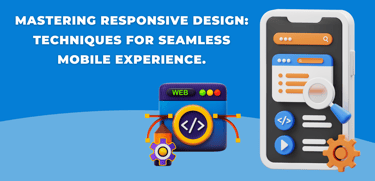
Responsive Design Mastery Elevating Mobile User Experiences by AZ Konnect
By AZ Konnect Team
1/11/20242 min read


Introduction: In today's digital landscape, delivering exceptional user experiences across devices is imperative. Responsive design stands as a fundamental element in ensuring websites adapt seamlessly to various screen sizes, especially on mobile devices. At AZ Konnect, we recognize the significance of mastering responsive design for optimal user engagement. This blog aims to elucidate techniques and strategies for mastering responsive design, guaranteeing a seamless and captivating mobile user experience.
Understanding Responsive Design Principles Introduce the core principles of responsive design, emphasizing fluid grids, flexible images, and media queries. Discuss the importance of a mobile-first approach and the concept of progressive enhancement.
Mobile-First Approach: Designing for Smaller Screens Discuss the mobile-first strategy, highlighting its importance in designing for smaller screens and focusing on essential content and functionalities. Explore how this approach enhances mobile usability and performance.
Flexible Grids and Layouts Delve into the implementation of flexible grid systems, emphasizing the use of percentages or relative units for layout elements to ensure adaptability across various screen sizes.
Fluid Images and Media Explore techniques for employing fluid images and scalable media, ensuring images and multimedia elements adjust proportionally to fit different screen sizes without losing quality.
Media Queries and Breakpoints Explain the role of media queries in responsive design, discussing how breakpoints are set to apply specific styles based on device characteristics like screen width, height, and orientation.
Viewport Meta Tag and Device Compatibility Highlight the importance of the viewport meta tag in responsive design, ensuring proper scaling and compatibility across different devices and browsers.
Font and Typography Considerations Discuss typography choices for responsive design, including the use of scalable fonts and the importance of readability and legibility on smaller screens.
Optimizing Navigation for Mobile Explore best practices for mobile navigation, such as collapsible menus, hamburger icons, and touch-friendly controls, ensuring ease of use and intuitive navigation on mobile devices.
Performance Optimization for Mobile Discuss performance optimization techniques specific to mobile devices, including image compression, lazy loading, and minimizing HTTP requests for faster load times.
Testing and Iteration Highlight the significance of testing responsive designs across multiple devices, browsers, and screen sizes. Emphasize the iterative nature of responsive design and the need for continuous improvements based on user feedback and testing results.
Conclusion: Mastering responsive design is fundamental in creating compelling and user-friendly experiences across all devices. At AZ Konnect, we advocate for the implementation of these techniques to ensure websites are not only visually appealing but also function seamlessly on mobile devices, enhancing user engagement and satisfaction. Embrace responsive design techniques to craft websites that adapt effortlessly to the ever-evolving digital landscape, fostering better connections with your audience on mobile platforms.
Subscribe To Our Newsletter


